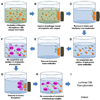Multiplexed magnetic microsphere immunoassays for detection of pathogens in foods
- PMID: 20953301
- PMCID: PMC2953821
- DOI: 10.1007/s11694-010-9097-x
Multiplexed magnetic microsphere immunoassays for detection of pathogens in foods
Abstract
Foodstuffs have traditionally been challenging matrices for conducting immunoassays. Proteins, carbohydrates, and other macromolecules present in food matrices may interfere with both immunoassays and PCR-based tests, and removal of particulate matter may also prove challenging prior to analyses. This has been found true when testing for bacterial contamination of foods using the standard polystyrene microspheres utilized with Luminex flow cytometers. Luminex MagPlex microspheres are encoded with the same dyes as standard xMAP microspheres, but have superparamagnetic properties to aid in preparation of samples in complex matrices. In this work, we present results demonstrating use of MagPlex for sample preparation and identification of bacteria and a toxin spiked into a variety of food samples. Fluorescence-coded MagPlex microsphere sets coated with antibodies for Salmonella, Campylobacter, Escherichia coli, Listeria, and staphylococcal enterotoxin B (SEB) were used to capture these bacteria and toxin from spiked foodstuffs and then evaluated by the Luminex system in a multiplex format; spiked foods included apple juice, green pepper, tomato, ground beef, alfalfa sprouts, milk, lettuce, spinach, and chicken washes. Although MagPlex microspheres facilitated recovery of the microspheres and targets from the complex matrices, assay sensitivity was sometimes inhibited by up to one to three orders of magnitude; for example the detection limits E. coli spiked into apple juice or milk increased 100-fold, from 1000 to 100,000 cfu/mL. Thus, while the magnetic and fluorescent properties of the Luminex MagPlex microspheres allow for rapid, multiplexed testing for bacterial contamination in typically problematic food matrices, our data demonstrate that achieving desired limits of detection is still a challenge.
Figures







Similar articles
-
Quantitative, multiplexed detection of bacterial pathogens: DNA and protein applications of the Luminex LabMAP system.J Microbiol Methods. 2003 May;53(2):245-52. doi: 10.1016/s0167-7012(03)00028-9. J Microbiol Methods. 2003. PMID: 12654495
-
Multiplexed Microsphere Suspension Array-Based Immunoassays.Methods Mol Biol. 2015;1318:107-18. doi: 10.1007/978-1-4939-2742-5_11. Methods Mol Biol. 2015. PMID: 26160569
-
Conversion of a capture ELISA to a Luminex xMAP assay using a multiplex antibody screening method.J Vis Exp. 2012 Jul 6;(65):4084. doi: 10.3791/4084. J Vis Exp. 2012. PMID: 22806215 Free PMC article.
-
Development of a fluorescent latex microparticle immunoassay for the detection of staphylococcal enterotoxin B (SEB).J Agric Food Chem. 2006 Jul 12;54(14):4937-42. doi: 10.1021/jf053253q. J Agric Food Chem. 2006. PMID: 16819899
-
Cell-based fluorescent microsphere incorporated with carbon dots as a sensitive immunosensor for the rapid detection of Escherichia coli O157 in milk.Biosens Bioelectron. 2021 May 1;179:113057. doi: 10.1016/j.bios.2021.113057. Epub 2021 Feb 2. Biosens Bioelectron. 2021. PMID: 33578111
Cited by
-
Same-day detection of Escherichia coli O157:H7 from spinach by using electrochemiluminescent and cytometric bead array biosensors.Appl Environ Microbiol. 2010 Dec;76(24):8044-52. doi: 10.1128/AEM.01990-10. Epub 2010 Oct 29. Appl Environ Microbiol. 2010. PMID: 21037307 Free PMC article.
-
Impact of Aerosol Dust on xMAP Multiplex Detection of Different Class Pathogens.Front Microbiol. 2017 Nov 29;8:2341. doi: 10.3389/fmicb.2017.02341. eCollection 2017. Front Microbiol. 2017. PMID: 29238328 Free PMC article.
-
xMAP Technology: Applications in Detection of Pathogens.Front Microbiol. 2017 Jan 25;8:55. doi: 10.3389/fmicb.2017.00055. eCollection 2017. Front Microbiol. 2017. PMID: 28179899 Free PMC article. Review.
-
Immunomagnetic microbeads for screening with flow cytometry and identification with nano-liquid chromatography mass spectrometry of ochratoxins in wheat and cereal.Anal Bioanal Chem. 2011 Jul;400(9):3085-96. doi: 10.1007/s00216-011-4974-7. Epub 2011 Apr 19. Anal Bioanal Chem. 2011. PMID: 21503734 Free PMC article.
-
Applications of nanotechnology in food packaging and food safety: barrier materials, antimicrobials and sensors.J Colloid Interface Sci. 2011 Nov 1;363(1):1-24. doi: 10.1016/j.jcis.2011.07.017. Epub 2011 Jul 23. J Colloid Interface Sci. 2011. PMID: 21824625 Free PMC article.
References
-
- Vignali DA. Multiplexed particle-based flow cytometric assays. J. Immunol. Methods. 2000;243(1–2):243–255. - PubMed
-
- Dunbar SA, Vander Zee CA, Oliver KG, Karem KL, Jacobson JW. Quantitative, multiplexed detection of bacterial pathogens: DNA and protein applications of the Luminex Lab-MAP system. J. Microbiol. Methods. 2003;53(2):245–252. - PubMed
-
- Ikeda M, Yamaguchi N, Tani K, Nasu M. Rapid and simple detection of food poisoning bacteria by bead assay with a microfluidic chip-based system. J. Microbiol. Methods. 2006;67(2):241–247. - PubMed
-
- Fantozzi A, Ermolli M, Marini M, Scotti D, Balla B, Querci M, Langrell SR, Van den Eede G. First application of a microsphere-based immunoassay to the detection of genetically modified organisms (GMOs): quantification of Cry1Ab protein in genetically modified maize. J. Agric. Food Chem. 2007;55(4):1071–1076. - PubMed
-
- Haasnoot W, du Pre JG. Luminex-based triplex immunoassay for the simultaneous detection of soy, pea, and soluble wheat proteins in milk powder. J. Agric. Food Chem. 2007;55(10):3771–3777. - PubMed
Grants and funding
LinkOut - more resources
Full Text Sources
Other Literature Sources
